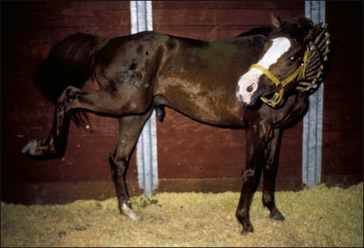15 Neurological disorders
It is easy to forget that the skin is a major sensory organ and that its neurological components are also subject to disease and injury. Whilst direct trauma is usually obvious and elicits the normal pain responses, alterations in a peripheral sensory nerve or within the central nervous system can have significant cutaneous signs. Psychosomatic self-trauma, pruritus and inappropriate sweating patterns are the main presentations of neurological skin disease.
Sweating is a major thermal control mechanism in horses and has been the focus of much attention both from the perspective of anhidrosis and as an indicator of autonomic neurological disturbances (Jenkinson et al 2006).
Psychogenic self-mutilation
Clinical signs
Affected animals usually bite at their flanks – most often forward of the stifle joint (Fig. 15.1). The bites can be quite vicious and may even break the skin.
 Key points: Psychogenic self-mutilation
Key points: Psychogenic self-mutilation
1. Rare condition mostly affecting stallions. Rarely affects other classes of horse but they can be severely affected and are usually presented as pruritus cases.
2. Signs relate to self-trauma – often at one site and usually the flank regions cranial to the stifle. Considerable skin damage can be done and long-standing cases often have gross thickening of the skin with variable degrees of hair loss and scarring. The horses can be distracted easily but return to the vice once the stimulus is removed.
3. Diagnosis is simply by observation and distraction. No specific cause can be identified.
4. Treatment involves changing the environment and reducing boredom but some cases continue regardless.
5. The prognosis for the animal is good but the condition is sometimes a persistent vice.
Differential diagnosis
• Ectoparasite infestations: seldom affect this region specifically. More often generalized pruritus. Easily diagnosed from brushings.
• Other causes of pruritus (see p. 442).
• Atopy: young horses with genuine pruritus that shifts from site to site in an unpredictable way.
• Cauda equina neuritis (polyneuritis equi): pruritus is not a common feature apart from in the early stages when perineal irritation can be present. There is usually perineal hypalgesia and tail and bladder paralysis.
• Trigeminal neuralgia/head-shaking syndromes: rare, involuntary hyper-reflexic/hyperaesthetic disorder affecting the facial skin only.
• Viral neurological pruritus: usually a single focus and the signs are rapidly progressive. The animal cannot be distracted from the site.
• Dermatophytosis (ringworm): characteristic epidemiology and only mildly pruritic in a few circumstances. Seldom affects the flank area. Size and shape of lesions and epidemiology are characteristic, self-resolving or responds to specific treatments; diagnostic mycology.
• Dermatophilosis: not pruritic.
Treatment
The only treatment is distraction – stable toys, a view of other horses and a reasonable distance away from stallions actually performing stud duties are helpful. Topical local anaesthetics do not help at all. Sedation or behaviour-altering drugs are a severe and unnecessary way to manage the problem (Dodman et al 1994).
Secondary infections and wound care may be needed as appropriate.
Stay updated, free articles. Join our Telegram channel

Full access? Get Clinical Tree










